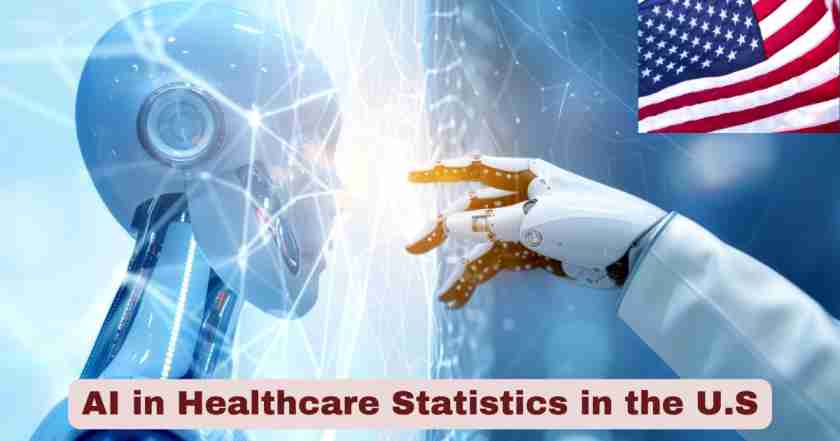AI in Healthcare in the US 2025
Artificial intelligence has emerged as a transformative force in American healthcare, fundamentally reshaping how medical professionals diagnose, treat, and monitor patients across the United States. Throughout 2024 and into 2025, the integration of AI technologies in healthcare settings has accelerated dramatically, driven by advances in machine learning algorithms, increased computational power, and the growing digitization of medical records. This technological revolution encompasses everything from diagnostic imaging and clinical decision support systems to predictive analytics and personalized treatment protocols.
The healthcare sector’s embrace of AI technologies represents one of the most significant shifts in medical practice since the advent of modern imaging techniques. From FDA-approved AI medical devices that can detect strokes and analyze medical images to sophisticated algorithms that predict patient deterioration in intensive care units, artificial intelligence is becoming an indispensable tool for healthcare providers. The year 2025 marks a particularly pivotal moment as healthcare organizations nationwide have moved beyond experimental implementations to widespread clinical deployment of AI solutions.
Key Stats & Facts About AI in Healthcare in the US 2025
| Statistic Category | 2025 Data | Source Context |
|---|---|---|
| FDA AI/ML Medical Device Approvals | Over 1,000 devices approved | FDA official database tracking |
| Annual AI Device Approvals | 221 devices approved in 2024 | Regulatory acceleration trend |
| First Half 2024 Approvals | 107 devices in 6 months | Unprecedented approval rate |
| Market Value Projection | $2+ billion in 2025 | Generative AI healthcare market |
| Growth Rate 2025-2028 | 146% increase expected | Market expansion forecast |
| Healthcare Data Volume | 10+ trillion gigabytes in 2025 | Medical data explosion index |
| Radiology AI Dominance | 75%+ of AI devices | Primary medical specialty focus |
| Clinical Performance Studies | Only 46.1% report comprehensive results | FDA approval transparency gap |
| Demographic Reporting | 3.6% report race/ethnicity data | Clinical trial diversity issue |
| FDA AI Team Reduction | 25% staff reduction in 2025 | Regulatory capacity concerns |
In 2025, the integration of Artificial Intelligence (AI) into U.S. healthcare reached a critical threshold, with over 1,000 AI/ML-enabled medical devices approved by the FDA, marking a significant milestone in digital health innovation. Radiology continues to dominate the field, comprising more than 75% of all approved AI medical devices, primarily due to AI’s proficiency in medical imaging interpretation. The market for generative AI in healthcare is projected to surpass $2 billion in 2025, fueled by the rapid expansion of applications such as diagnostics, administrative automation, and patient engagement tools. The volume of healthcare data generated—more than 10 trillion gigabytes—has accelerated demand for AI tools capable of managing and extracting insights from such massive datasets.
However, regulatory and ethical challenges remain. Despite the impressive number of approvals, only 46.1% of clinical performance studies submitted to the FDA in 2025 reported full results, highlighting a persistent transparency gap. Even more concerning, just 3.6% of AI device approvals included demographic data on race or ethnicity, revealing a major shortfall in clinical trial diversity—an issue critical to equitable healthcare delivery. Compounding the challenge is a 25% reduction in FDA staff focused on AI/ML oversight, raising concerns about the agency’s capacity to manage the flood of new AI tools. As adoption surges, stakeholders must address these governance, equity, and infrastructure issues to ensure AI delivers safe and fair outcomes in healthcare.
FDA AI Medical Device Approvals in the US 2025
| Approval Metrics | Current Status | Trend Analysis |
|---|---|---|
| Total Cumulative Approvals | 1,000+ devices | Milestone achievement |
| 2024 Annual Record | 221 new approvals | Historic high |
| Average Monthly Rate 2024 | 18.4 devices per month | Accelerating pace |
| Radiology Specialization | ~750 devices | Dominant application area |
| Cardiovascular Applications | ~120 devices | Second largest category |
| Neurology Applications | ~80 devices | Growing specialty focus |
| 510(k) Clearance Pathway | 85%+ of approvals | Primary regulatory route |
| De Novo Pathway Usage | ~5% of approvals | Novel device classifications |
| PMA Approval Rate | <3% of total | Highest risk devices |
| Average Review Timeline | 4-6 months | Expedited processing |
The FDA’s AI-enabled medical device approval data reveals the overwhelming concentration of artificial intelligence applications in diagnostic imaging, particularly radiology. This specialization reflects both the maturity of computer vision technology and the digitized nature of medical imaging data that makes it ideal for AI analysis. The predominance of 510(k) clearance pathways indicates that most AI medical devices are being approved as substantially equivalent to existing technologies, rather than as breakthrough innovations requiring more rigorous review processes.
The rapid approval timeline of 4-6 months demonstrates the FDA’s commitment to expediting beneficial AI technologies to market, yet this speed must be balanced against thorough safety evaluation. The relatively low utilization of the more stringent PMA pathway suggests that most AI medical devices are being classified as moderate-risk rather than high-risk technologies, though this classification approach continues to evolve as AI capabilities advance.
Market Growth and Economic Impact in the US 2025
| Economic Indicators | 2025 Projections | Growth Trajectory |
|---|---|---|
| Generative AI Market Value | $2.1 billion | First-time threshold crossing |
| 2025-2028 Growth Rate | 146% increase | Compound annual expansion |
| 2030 Market Projection | $10+ billion | Exponential scaling |
| Healthcare AI Investment | $15+ billion annually | Venture and institutional funding |
| Cost Savings Potential | $150 billion annually | Efficiency and error reduction |
| ROI Timeline | 18-24 months | Accelerated payback periods |
| Productivity Gains | 25-40% improvement | Clinical workflow optimization |
| Healthcare Employment Impact | Net positive job creation | Skill transformation requirement |
| Technology Adoption Rate | 65% of hospitals | Mainstream integration |
| Small Practice Adoption | 35% penetration | Digital divide concerns |
The economic transformation of healthcare through AI represents one of the most significant technological shifts in the sector’s history. The generative AI healthcare market crossing the $2 billion threshold in 2025 marks a critical inflection point, with projections indicating a 146% growth rate through 2028 that would establish a $10+ billion market by 2030. This explosive growth reflects both the technological maturation of AI systems and healthcare organizations’ increasing confidence in AI-driven solutions.
The potential for $150 billion in annual cost savings through improved efficiency and reduced medical errors represents a compelling economic argument for AI adoption. However, the disparity between large hospital systems (65% adoption) and smaller practices (35% adoption) highlights the digital divide that threatens to exacerbate healthcare access inequalities if not addressed through targeted support and training programs.
Clinical Implementation Challenges in the US 2025
| Implementation Barriers | Current Status | Impact Assessment |
|---|---|---|
| Clinical Study Reporting | 46.1% provide comprehensive data | Transparency deficit |
| Race/Ethnicity Reporting | 3.6% of approvals | Bias and equity concerns |
| Socioeconomic Data | 0.9% inclusion rate | Health disparities blind spot |
| Age Demographics | 18.4% report subject ages | Generalizability limitations |
| Scientific Publication | 1.9% link to peer review | Academic validation gap |
| Real-world Performance | Variable outcomes | Implementation inconsistency |
| Provider Training Needs | High demand | Workforce development gap |
| Integration Complexity | Significant challenge | Technical infrastructure strain |
| Data Quality Issues | Ongoing concern | Accuracy and completeness |
| Regulatory Compliance | Evolving requirements | Moving target challenges |
The clinical implementation of AI in healthcare faces significant challenges that extend far beyond technological capabilities. The alarming lack of comprehensive clinical performance reporting—with only 46.1% of FDA-approved devices providing detailed study results—represents a critical transparency gap that undermines evidence-based adoption decisions. Even more concerning is the near-complete absence of demographic diversity data, with only 3.6% of approvals reporting race and ethnicity information.
This data scarcity creates substantial risks for healthcare equity, as AI systems trained on homogeneous populations may perform poorly for underrepresented groups. The minimal connection to peer-reviewed research (1.9% of approvals) further compounds concerns about the scientific rigor underlying AI medical device approvals and their real-world effectiveness across diverse patient populations.
Future Outlook and Regulatory Evolution in the US 2025
| Regulatory Trends | 2025 Status | Future Implications |
|---|---|---|
| Regulatory Staff Capacity | 25% reduction | Review bottleneck risk |
| Approval Process Speed | Accelerating | Balance with safety concerns |
| Post-market Surveillance | Enhanced requirements | Real-world performance monitoring |
| AI Transparency Rules | Under development | Algorithm explainability mandates |
| International Harmonization | Progressing slowly | Global market access complexity |
| Cybersecurity Standards | Tightening requirements | Device security imperatives |
| Bias Detection Protocols | Emerging frameworks | Equity assurance mechanisms |
| Continuous Learning Systems | Regulatory uncertainty | Adaptive algorithm challenges |
| Healthcare Integration | Mainstream adoption | Standard of care evolution |
| Provider Liability | Legal framework development | Malpractice implications |
The regulatory landscape for AI in healthcare is evolving rapidly as the FDA and other agencies struggle to balance innovation promotion with patient safety protection. The 25% reduction in FDA AI review staff creates concerning capacity constraints just as AI device submissions reach historic highs. This staffing challenge may force the agency to rely more heavily on industry self-assessment and post-market surveillance rather than comprehensive pre-market review.
Looking ahead, the development of AI transparency rules and bias detection protocols will likely reshape how AI medical devices are developed, validated, and deployed. Healthcare organizations must prepare for more stringent requirements around algorithm explainability and demographic performance validation, while simultaneously investing in the technical infrastructure and workforce development necessary to realize AI’s transformative potential in American healthcare.
Disclaimer: The data research report we present here is based on information found from various sources. We are not liable for any financial loss, errors, or damages of any kind that may result from the use of the information herein. We acknowledge that though we try to report accurately, we cannot verify the absolute facts of everything that has been represented.







